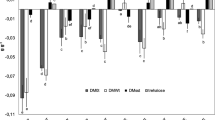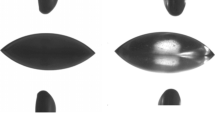Abstract
Carrots are worldwide highly consumed due to their sensory characteristics and health-promoting properties. However, their low phenolic/antioxidant levels may be highly increased with abiotic stresses. Accordingly, phenolic/antioxidant enhancements and related phenylalanine ammonia-lyase (PAL) activity of carrot shreds under different treatments (UV-C radiation and hyperoxia conditions) were studied after a pre-enrichment incubation of 72 h at 15 °C. Subsequently, a carrot smoothie prepared from enriched carrot shreds was heat-treated (90 °C for 30 s) and stored at 5 °C up to 14 days. Heat-treated smoothies showed a good physicochemical and microbiological quality (<6 log CFU g−1) after 14 days at 5 °C, although those non-irradiated samples registered lower psychrophilic and yeast and mold levels. Heat-treated smoothie from non-irradiated shreds stored under hyperoxia conditions showed the highest total phenolic content of 13.82 mg chlorogenic acid equivalent (ChAE) kg−1 fw (87 % chlorogenic acid) after 14 days at 5 °C. Total phenolic content was in accordance with PAL and total antioxidant capacity. Conclusively, a pre-enrichment incubation of carrot shreds under hyperoxia conditions allowed to obtain a functional smoothie with high phenolic levels and good microbiological and physicochemical quality up to 14 days at 5 °C.

Similar content being viewed by others
References
Alegria, C. (2015). Heat shock and UV-C abiotic stress treatments as alternative tools to promote fresh-cut carrot quality and shelf-life. PhD Thesis. University of Lisbon.
Alegria, C., Pinheiro, J., Duthoit, M., Gonçalves, E. M., Moldão-Martins, M., & Abreu, M. (2012). Fresh-cut carrot (cv. Nantes) quality as affected by abiotic stress (heat shock and UV-C irradiation) pre-treatments. LWT - Food Science and Technology, 48(2), 197–203. doi:10.1016/j.lwt.2012.03.013.
Alegria, C., Pinheiro, J., Gonçalves, E. M., Fernandes, I., Moldão, M., & Abreu, M. (2010). Evaluation of a pre-cut heat treatment as an alternative to chlorine in minimally processed shredded carrot. Innovative Food Science & Emerging Technologies, 11(1), 155–161. doi:10.1016/j.ifset.2009.10.008.
Amanatidou, A., Slump, R. A., Gorris, L. G. M., & Smid, E. J. (2000). High oxygen and high carbon dioxide modified atmospheres for shelf-life extension of minimally processed carrots. Journal of Food Science, 65(1), 61–66. doi:10.1111/j.1365-2621.2000.tb15956.x.
Artés, F., Gómez, P., Aguayo, E., Escalona, V., & Artés-Hernández, F. (2009). Sustainable sanitation techniques for keeping quality and safety of fresh-cut plant commodities. Postharvest Biology and Technology, 51(3), 287–296. doi:10.1016/j.postharvbio.2008.10.003.
Artés-Hernández, F., Escalona, V. H., Robles, P. A., Martínez-Hernández, G. B., & Artés, F. (2009). Effect of UV-C radiation on quality of minimally processed spinach leaves. Journal of the Science of Food and Agriculture, 89(3), 414–421. doi:10.1002/jsfa.3460.
Avena-Bustillos, R. J., Du, W. X., Woods, R., Olson, D., Breksa 3rd, A. P., & McHugh, T. H. (2012). Ultraviolet-B light treatment increases antioxidant capacity of carrot products. Journal of the Science of Food and Agriculture, 92(11), 2341–2348. doi:10.1002/jsfa.5635.
Becerra-Moreno, A., Benavides, J., Cisneros-Zevallos, L., & Jacobo-Velázquez, D. A. (2012). Plants as biofactories: glyphosate-induced production of shikimic acid and phenolic antioxidants in wounded carrot tissue. Journal of Agricultural and Food Chemistry, 60(45), 11378–11386. doi:10.1021/jf303252v.
Ben Said, M., Masahiro, O., & Hassen, A. (2010). Detection of viable but non cultivable Escherichia coli after UV irradiation using a lytic Qβ phage. Annals of Microbiology, 60(1), 121–127. doi:10.1007/s13213-010-0017-4.
Beuchat, L. R., & Brackett, R. E. (1990). Inhibitory effects of raw carrots on Listeria monocytogenes. Applied and Environmental Microbiology, 56(6), 1734–1742.
Bintsis, T., Litopoulou-Tzanetaki, E., & Robinson, R. K. (2000). Existing and potential applications of ultraviolet light in the food industry—a critical review. Journal of the Science of Food and Agriculture, 80(6), 637–645. doi:10.1002/(SICI)1097-0010(20000501)80:6<637::AID-JSFA603>3.0.CO;2-1.
Brand-Williams, W., Cuvelier, M., & Berset, C. (1995). Use of a free radical method to evaluate antioxidant activity. LWT-Food Science and Technology, 28(1), 25–30.
Castelluccio, C., Paganga, G., Melikian, N., Bolwell, G. P., Pridham, J., Sampson, J., et al. (1995). Antioxidant potential of intermediates in phenylpropanoid metabolism in higher plants. FEBS Letters, 368(1), 188–192.
Castillejo, N., Martínez-Hernández, G. B., Gómez, P. A., Artés, F., & Artés-Hernández, F. (2015). Red fresh vegetables smoothies with extended shelf life as an innovative source of health-promoting compounds. [journal article]. Journal of Food Science and Technology, 1–12, 10.1007/s13197–015–2143-2.
Chun, O. K., Kim, D.-O., Smith, N., Schroeder, D., Han, J. T., & Lee, C. Y. (2005). Daily consumption of phenolics and total antioxidant capacity from fruit and vegetables in the American diet. Journal of the Science of Food and Agriculture, 85(10), 1715–1724. doi:10.1002/jsfa.2176.
Cisneros-Zevallos, L. (2003). The use of controlled postharvest abiotic stresses as a tool for enhancing the nutraceutical content and adding-value of fresh fruits and vegetables. Journal of Food Science, 68(5), 1560–1565. doi:10.1111/j.1365-2621.2003.tb12291.x.
Commission Regulation (EC) No. 1441/2007 (2007). Official Journal of the European Union, 322, 12–29.
Conesa, R., Andreu, S., Fernandez, P. S., Esnoz, A., & Palop, A. (2009). Nonisothermal heat resistance determinations with the thermoresistometer Mastia. Journal of Applied Microbiology, 107(2), 506–513. doi:10.1111/j.1365-2672.2009.04236.x.
Cuéllar-Villarreal, M. D. R., Ortega-Hernández, E., Becerra-Moreno, A., Welti-Chanes, J., Cisneros-Zevallos, L., & Jacobo-Velázquez, D. A. (2016). Effects of ultrasound treatment and storage time on the extractability and biosynthesis of nutraceuticals in carrot (Daucus carota). Postharvest Biology and Technology, 119, 18–26. doi:10.1016/j.postharvbio.2016.04.013.
Dixon, R. A., & Paiva, N. L. (1995). Stress-induced phenylpropanoid metabolism. The Plant Cell, 7(7), 1085–1097.
EC_1441/2007 (2007). Commission regulation on microbiological criteria for foodstuffs. Official Journal of the European Union, 32.
El Gharras, H. (2009). Polyphenols: food sources, properties and applications—a review. International Journal of Food Science & Technology, 44(12), 2512–2518. doi:10.1111/j.1365-2621.2009.02077.x.
Gareth Rees, D., & Hugh Jones, D. (1996). Stability of l-phenylalanine ammonia-lyase in aqueous solution and as the solid state in air and organic solvents. Enzyme and Microbial Technology, 19(4), 282–288. doi:10.1016/0141-0229(95)00247-2.
Heredia, J. B., & Cisneros-Zevallos, L. (2009). The effect of exogenous ethylene and methyl jasmonate on pal activity, phenolic profiles and antioxidant capacity of carrots (Daucus carota) under different wounding intensities. Postharvest Biology and Technology, 51(2), 242–249. doi:10.1016/j.postharvbio.2008.07.001.
Jacobo-Velázquez, D. A., Martínez-Hernández, G. B., del Rodríguez, C. S., Cao, C.-M., & Cisneros-Zevallos, L. (2011). Plants as biofactories: physiological role of reactive oxygen species on the accumulation of phenolic antioxidants in carrot tissue under wounding and hyperoxia stress. Journal of Agricultural and Food Chemistry, 59(12), 6583–6593. doi:10.1021/jf2006529.
Kader, A. A., & Ben-Yehoshua, S. (2000). Effects of superatmospheric oxygen levels on postharvest physiology and quality of fresh fruits and vegetables. Postharvest Biology and Technology, 20(1), 1–13. doi:10.1016/S0925-5214(00)00122-8.
Kaur, M., & Sharma, H. K. (2013). Effect of enzymatic treatment on carrot cell wall for increased juice yield and effect on physicochemical parameters. African Journal of Plant Science, 7(6), 234–243.
Ke, D., & Saltveit, M. E. (1986). Effects of calcium and auxin on russet spotting and phenylalanine ammonia-lyase activity in iceberg lettuce. Hortscience, 21(5), 1169–1171.
Knockaert, G., Lemmens, L., Van Buggenhout, S., Hendrickx, M., & Van Loey, A. (2012). Changes in β-carotene bioaccessibility and concentration during processing of carrot puree. Food Chemistry, 133(1), 60–67. doi:10.1016/j.foodchem.2011.12.066.
Leistner, L. (2000). Basic aspects of food preservation by hurdle technology. International Journal of Food Microbiology, 55(1–3), 181–186. doi:10.1016/S0168-1605(00)00161-6.
Lemmens, L., De Vleeschouwer, K., Moelants, K. R. N., Colle, I. J. P., Van Loey, A. M., & Hendrickx, M. E. (2010). β-carotene isomerization kinetics during thermal treatments of carrot puree. Journal of Agricultural and Food Chemistry, 58(11), 6816–6824. doi:10.1021/jf100449t.
Martínez-Hernández, G. B., Amodio, M. L., & Colelli, G. (2016). Potential use of microwave treatment on fresh-cut carrots: physical, chemical and microbiological aspects. Journal of the Science of Food and Agriculture, 96(6), 2063–2072. doi:10.1002/jsfa.7319.
Martínez-Hernández, G. B., Artés-Hernández, F., Gómez, P. A., Formica, A. C., & Artés, F. (2013). Combination of electrolysed water, UV-C and superatmospheric O2 packaging for improving fresh-cut broccoli quality. Postharvest Biology and Technology, 76, 125–134. doi:10.1016/j.postharvbio.2012.09.013.
Martínez-Hernández, G. B., Gómez, P. A., Pradas, I., Artés, F., & Artés-Hernández, F. (2011). Moderate UV-C pretreatment as a quality enhancement tool in fresh-cut Bimi® broccoli. Postharvest Biology and Technology, 62(3), 327–337. doi:10.1016/j.postharvbio.2011.06.015.
Marx, M., Stuparic, M., Schieber, A., & Carle, R. (2003). Effects of thermal processing on trans–cis-isomerization of β-carotene in carrot juices and carotene-containing preparations. Food Chemistry, 83(4), 609–617. doi:10.1016/S0308-8146(03)00255-3.
Palou, E., López-Malo, A., Barbosa-Cánovas, G. V., Welti-Chanes, J., & Swanson, B. G. (1999). Polyphenoloxidase activity and color of blanched and high hydrostatic pressure treated banana puree. Journal of Food Science, 64(1), 42–45. doi:10.1111/j.1365-2621.1999.tb09857.x.
Patras, A., Brunton, N., Da Pieve, S., Butler, F., & Downey, G. (2009). Effect of thermal and high pressure processing on antioxidant activity and instrumental colour of tomato and carrot purées. Innovative Food Science & Emerging Technologies, 10(1), 16–22. doi:10.1016/j.ifset.2008.09.008.
Pushkala, R., Parvathy, K. R., & Srividya, N. (2012). Chitosan powder coating, a novel simple technique for enhancement of shelf life quality of carrot shreds stored in macro perforated LDPE packs. Innovative Food Science & Emerging Technologies, 16, 11–20. doi:10.1016/j.ifset.2012.03.003.
Quitão-Teixeira, L. J., Odriozola-Serrano, I., Soliva-Fortuny, R., Mota-Ramos, A., & Martín-Belloso, O. (2009). Comparative study on antioxidant properties of carrot juice stabilised by high-intensity pulsed electric fields or heat treatments. Journal of the Science of Food and Agriculture, 89(15), 2636–2642. doi:10.1002/jsfa.3767.
Reyes, L. F., Villarreal, J. E., & Cisneros-Zevallos, L. (2007). The increase in antioxidant capacity after wounding depends on the type of fruit or vegetable tissue. Food Chemistry, 101(3), 1254–1262. doi:10.1016/j.foodchem.2006.03.032.
Rodríguez-Verástegui, L. L., Martínez-Hernández, G. B., Castillejo, N., Gómez, P. A., Artés, F., & Artés-Hernández, F. (2015). Bioactive compounds and enzymatic activity of red vegetable smoothies during storage. [journal article]. Food and Bioprocess Technology, 9(1), 137–146. doi:10.1007/s11947-015-1609-6.
Slavin, J. L., & Lloyd, B. (2012). Health benefits of fruits and vegetables. Advances in Nutrition: An International Review Journal, 3(4), 506–516. doi:10.3945/an.112.002154.
Talcott, S. T., & Howard, L. R. (1999). Phenolic autoxidation is responsible for color degradation in processed carrot puree. Journal of Agricultural and Food Chemistry, 47(5), 2109–2115. doi:10.1021/jf981134n.
Tamminen, M., Salminen, S., & Ouwehand, A. C. (2013). Fermentation of carrot juice by probiotics: viability and preservation of adhesion. International Journal of Biotechnology for Wellness Industries, 2, 10–15.
Tomás-Barberán, F. A., & Espín, J. C. (2001). Phenolic compounds and related enzymes as determinants of quality in fruits and vegetables. Journal of the Science of Food and Agriculture, 81(9), 853–876. doi:10.1002/jsfa.885.
Wen, A., Delaquis, P., Stanich, K., & Toivonen, P. (2003). Antilisterial activity of selected phenolic acids. Food Microbiology, 20(3), 305–311. doi:10.1016/S0740-0020(02)00135-1.
Yang, Z., Zheng, Y., & Cao, S. (2009). Effect of high oxygen atmosphere storage on quality, antioxidant enzymes, and DPPH-radical scavenging activity of Chinese bayberry fruit. Journal of Agricultural and Food Chemistry, 57(1), 176–181. doi:10.1021/jf803007j.
Yu, L. J., & Rupasinghe, H. P. V. (2012). Effect of acidification on quality and shelf-life of carrot juice. Canadian Journal of Plant Science, 92(6), 1113–1120. doi:10.4141/cjps2011-206.
Zheng, Y., Wang, C. Y., Wang, S. Y., & Zheng, W. (2003). Effect of high-oxygen atmospheres on blueberry phenolics, anthocyanins, and antioxidant capacity. Journal of Agricultural and Food Chemistry, 51(24), 7162–7169. doi:10.1021/jf030440k.
Acknowledgements
Authors are grateful to the Spanish Ministry Economy and Competitiveness (Project AGL2013-48830-C2-1-R) and FEDER for financial support. We are grateful to V. Díaz-López for his skillful technical assistance.
Author information
Authors and Affiliations
Corresponding author
Rights and permissions
About this article
Cite this article
Formica-Oliveira, A.C., Martínez-Hernández, G.B., Aguayo, E. et al. A Functional Smoothie from Carrots with Induced Enhanced Phenolic Content. Food Bioprocess Technol 10, 491–502 (2017). https://doi.org/10.1007/s11947-016-1829-4
Received:
Accepted:
Published:
Issue Date:
DOI: https://doi.org/10.1007/s11947-016-1829-4




